height TOYOTA LAND CRUISER 2021 Owners Manual (in English)
[x] Cancel search | Manufacturer: TOYOTA, Model Year: 2021, Model line: LAND CRUISER, Model: TOYOTA LAND CRUISER 2021Pages: 632, PDF Size: 13.87 MB
Page 35 of 632
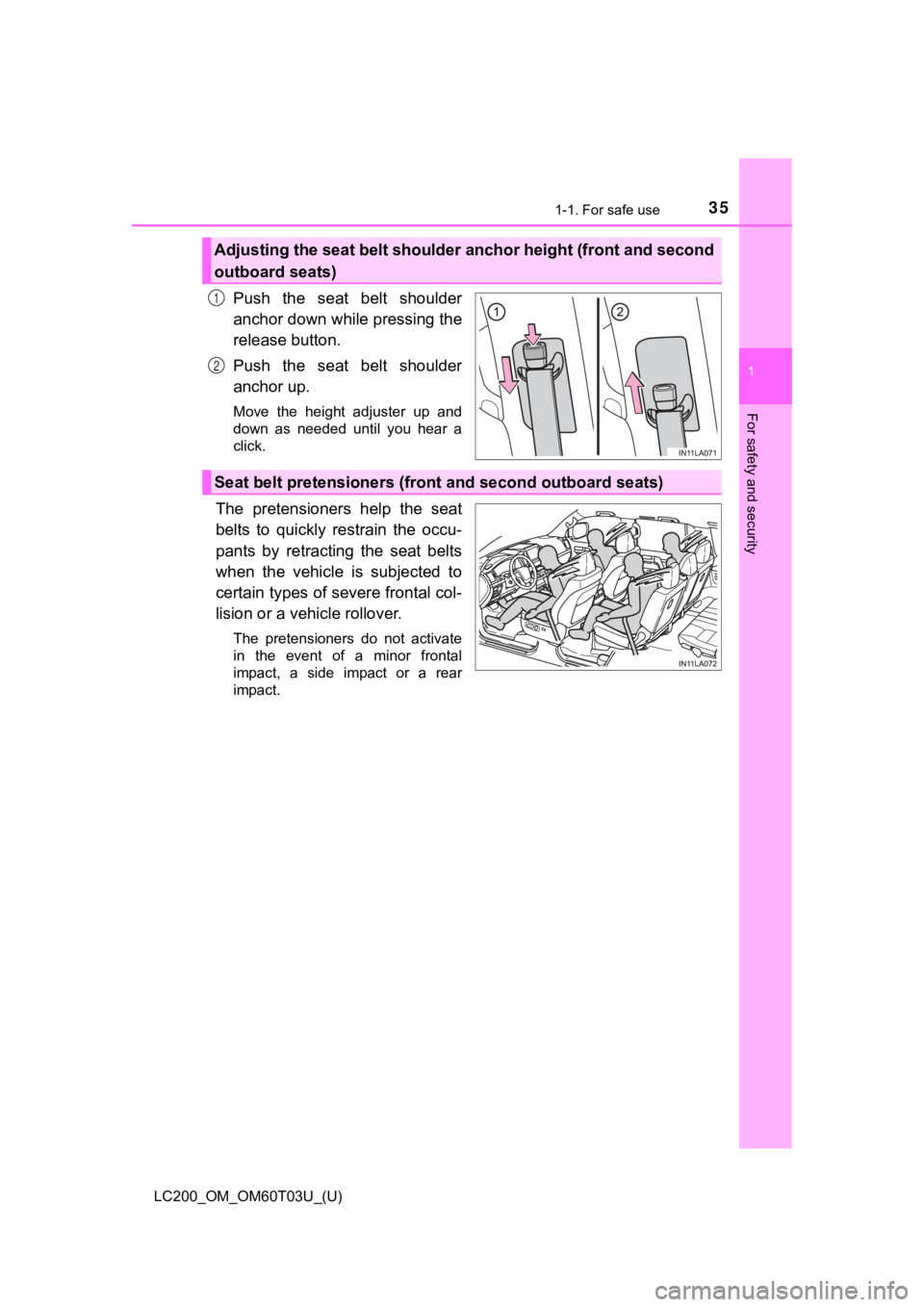
351-1. For safe use
LC200_OM_OM60T03U_(U)
1
For safety and security
Push the seat belt shoulder
anchor down while pressing the
release button.
Push the seat belt shoulder
anchor up.
Move the height adjuster up and
down as needed until you hear a
click.
The pretensioners help the seat
belts to quickly restrain the occu-
pants by retracting the seat belts
when the vehicle is subjected to
certain types of severe frontal col-
lision or a vehicle rollover.
The pretensioners do not activate
in the event of a minor frontal
impact, a side impact or a rear
impact.
Adjusting the seat belt shoulder anchor height (front and second
outboard seats)
1
2
Seat belt pretensioners (fron t and second outboard seats)
Page 63 of 632
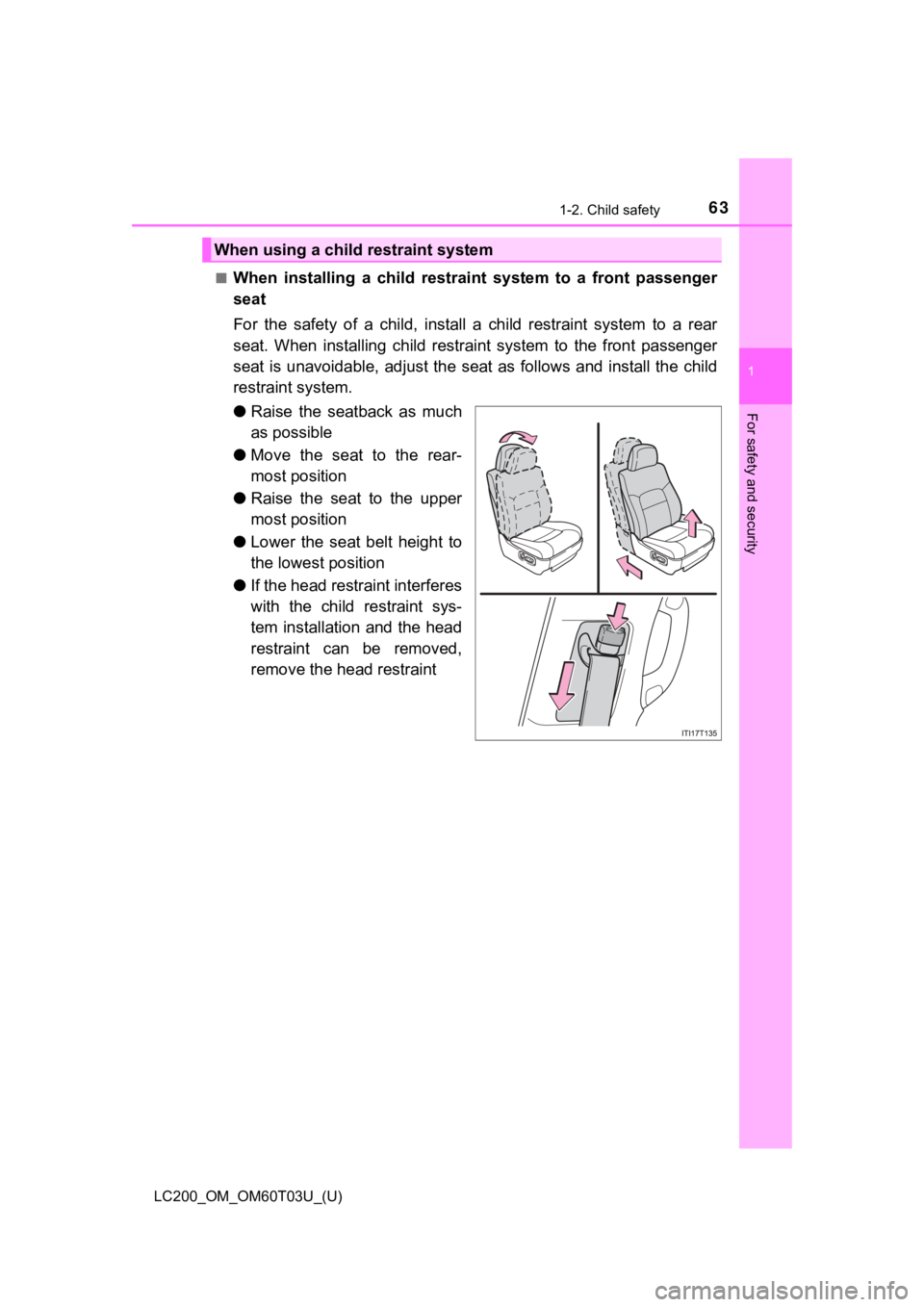
631-2. Child safety
LC200_OM_OM60T03U_(U)
1
For safety and security
■When installing a child restraint system to a front passenger
seat
For the safety of a child, install a child restraint system to a rear
seat. When installing child restraint system to the front passe nger
seat is unavoidable, adj ust the seat as follows and install the child
restraint system.
● Raise the seatback as much
as possible
● Move the seat to the rear-
most position
● Raise the seat to the upper
most position
● Lower the seat belt height to
the lowest position
● If the head restraint interferes
with the child restraint sys-
tem installation and the head
restraint can be removed,
remove the head restraint
When using a child restraint system
Page 145 of 632
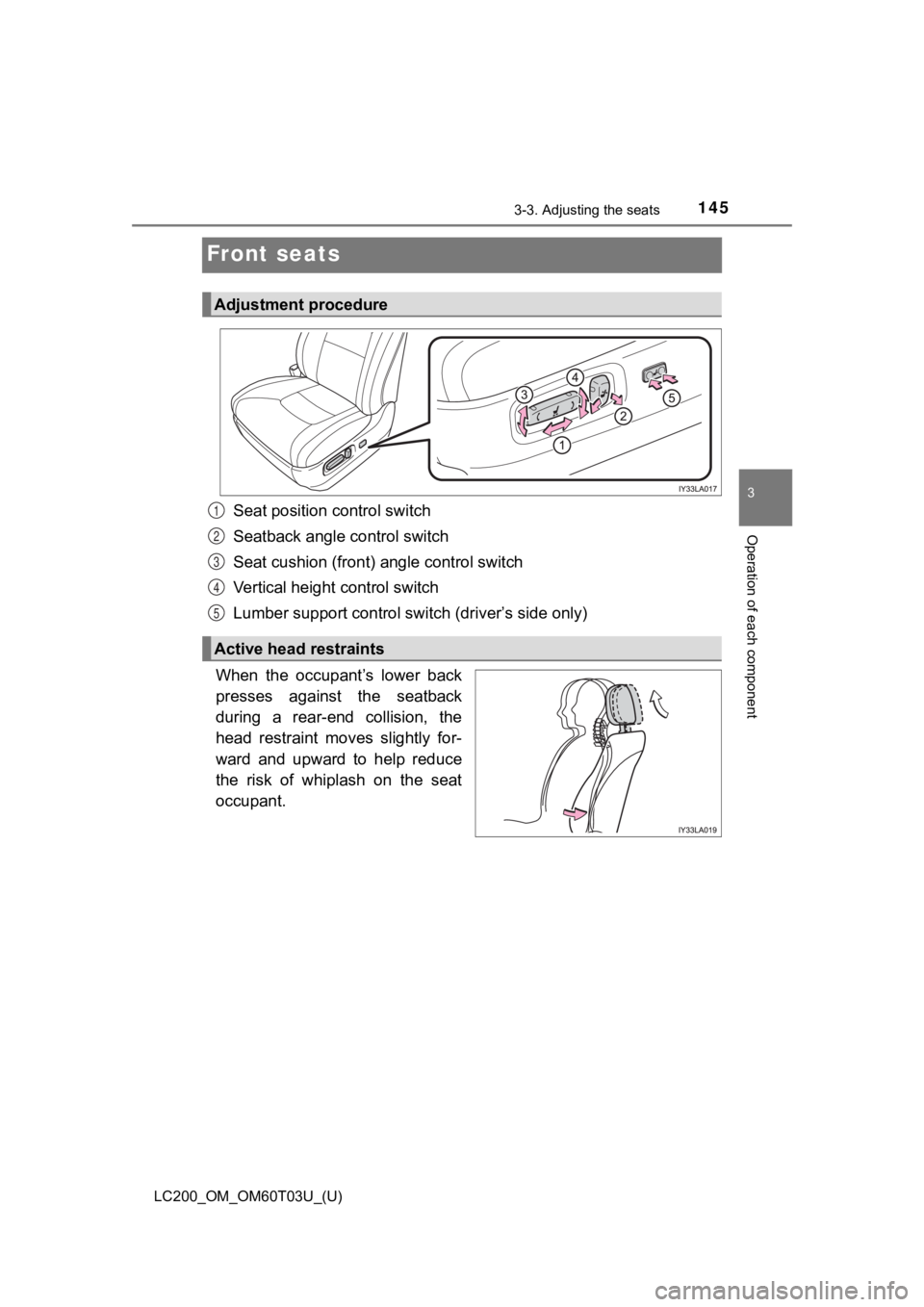
145
LC200_OM_OM60T03U_(U)
3-3. Adjusting the seats
3
Operation of each component
Front seats
Seat position control switch
Seatback angle control switch
Seat cushion (front) angle control switch
Vertical height control switch
Lumber support control sw itch (driver’s side only)
When the occupant’s lower back
presses against the seatback
during a rear-end collision, the
head restraint moves slightly for-
ward and upward to help reduce
the risk of whiplash on the seat
occupant.
Adjustment procedure
Active head restraints
1
2
3
4
5
Page 159 of 632
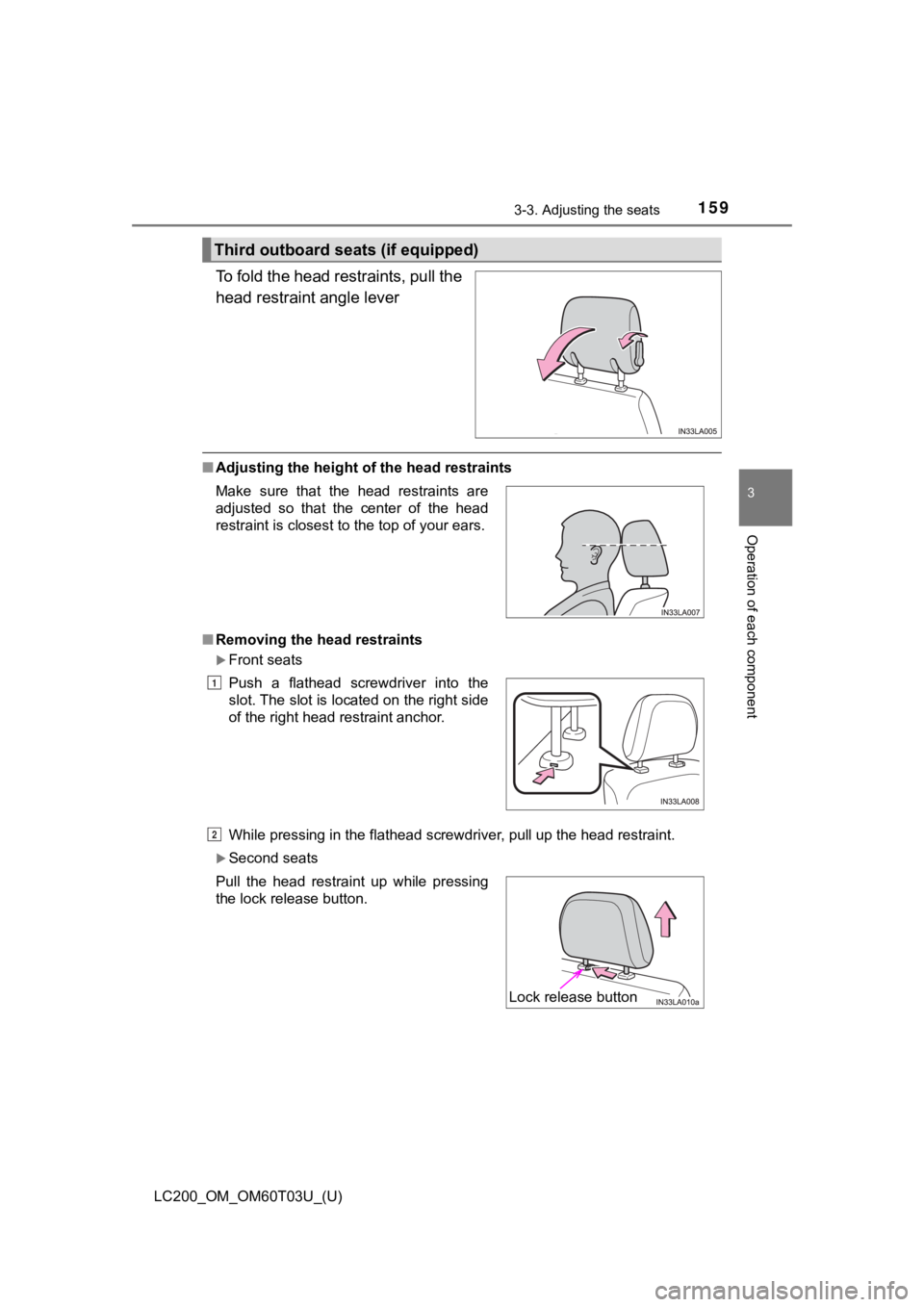
LC200_OM_OM60T03U_(U)
1593-3. Adjusting the seats
3
Operation of each component
To fold the head restraints, pull the
head restraint angle lever
■Adjusting the height o f the head restraints
■ Removing the head restraints
Front seats
While pressing in the flathead screwdriver, pull up the head restraint.
Second seats
Third outboard seats (if equipped)
Make sure that the head restraints are
adjusted so that the center of the head
restraint is closest to the top of your ears.
Push a flathead screwdriver into the
slot. The slot is located on the right side
of the right head restraint anchor.
Pull the head restraint up while pressing
the lock release button.
1
2
Lock release button
Page 163 of 632
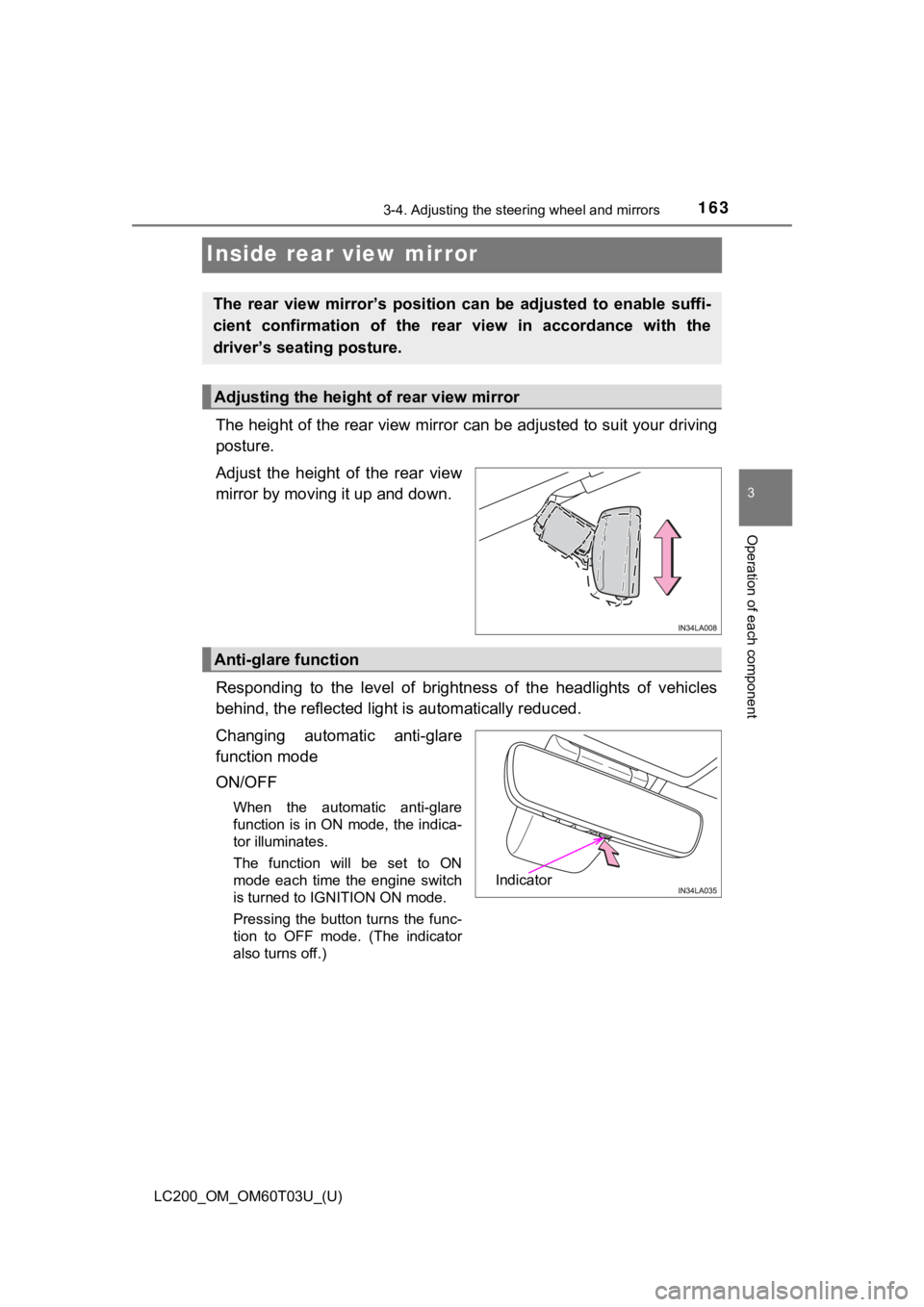
1633-4. Adjusting the steering wheel and mirrors
3
Operation of each component
LC200_OM_OM60T03U_(U)
Inside rear view mirror
The height of the rear view mirror can be adjusted to suit your driving
posture.
Adjust the height of the rear view
mirror by moving it up and down.
Responding to the level of brightness of the headlights of vehi cles
behind, the reflected light is automatically reduced.
Changing automatic anti-glare
function mode
ON/OFF
When the automatic anti-glare
function is in ON mode, the indica-
tor illuminates.
The function will be set to ON
mode each time the engine switch
is turned to IGNITION ON mode.
Pressing the button turns the func-
tion to OFF mode. (The indicator
also turns off.)
The rear view mirror’s position ca n be adjusted to enable suffi-
cient confirmation of the rear view in accordance with the
driver’s seating posture.
Adjusting the height of rear view mirror
Anti-glare function
Indicator
Page 199 of 632
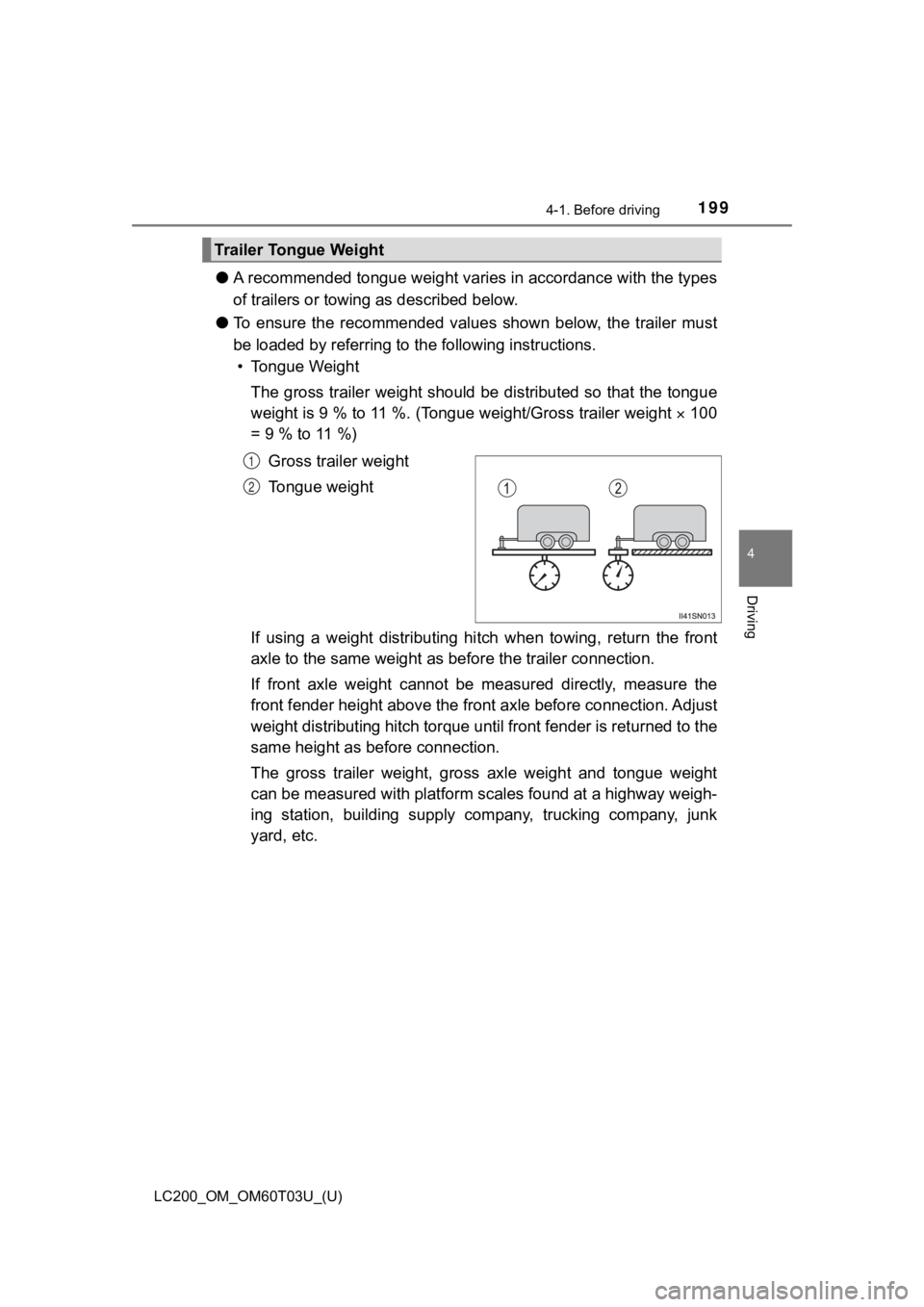
LC200_OM_OM60T03U_(U)
1994-1. Before driving
4
Driving
●A recommended tongue weight varies in accordance with the types
of trailers or towing as described below.
● To ensure the recommended values shown below, the trailer must
be loaded by referring to t he following instructions.
• Tongue Weight
The gross trailer weight should be distributed so that the tong ue
weight is 9 % to 11 %. (Tongue weight/Gross trailer weight 100
= 9 % to 11 %)
Gross trailer weight
Tongue weight
If using a weight distributing hi tch when towing, return the front
axle to the same weight as b efore the trailer connection.
If front axle weight cannot be measured directly, measure the
front fender height above the front axle before connection. Adjust
weight distributing hitch torque until front fender is returned to the
same height as b efore connection.
The gross trailer weight, gross axle weight and tongue weight
can be measured with platform sca les found at a highway weigh-
ing station, building supply company, trucking company, junk
yard, etc.
Trailer Tongue Weight
1
2
Page 206 of 632
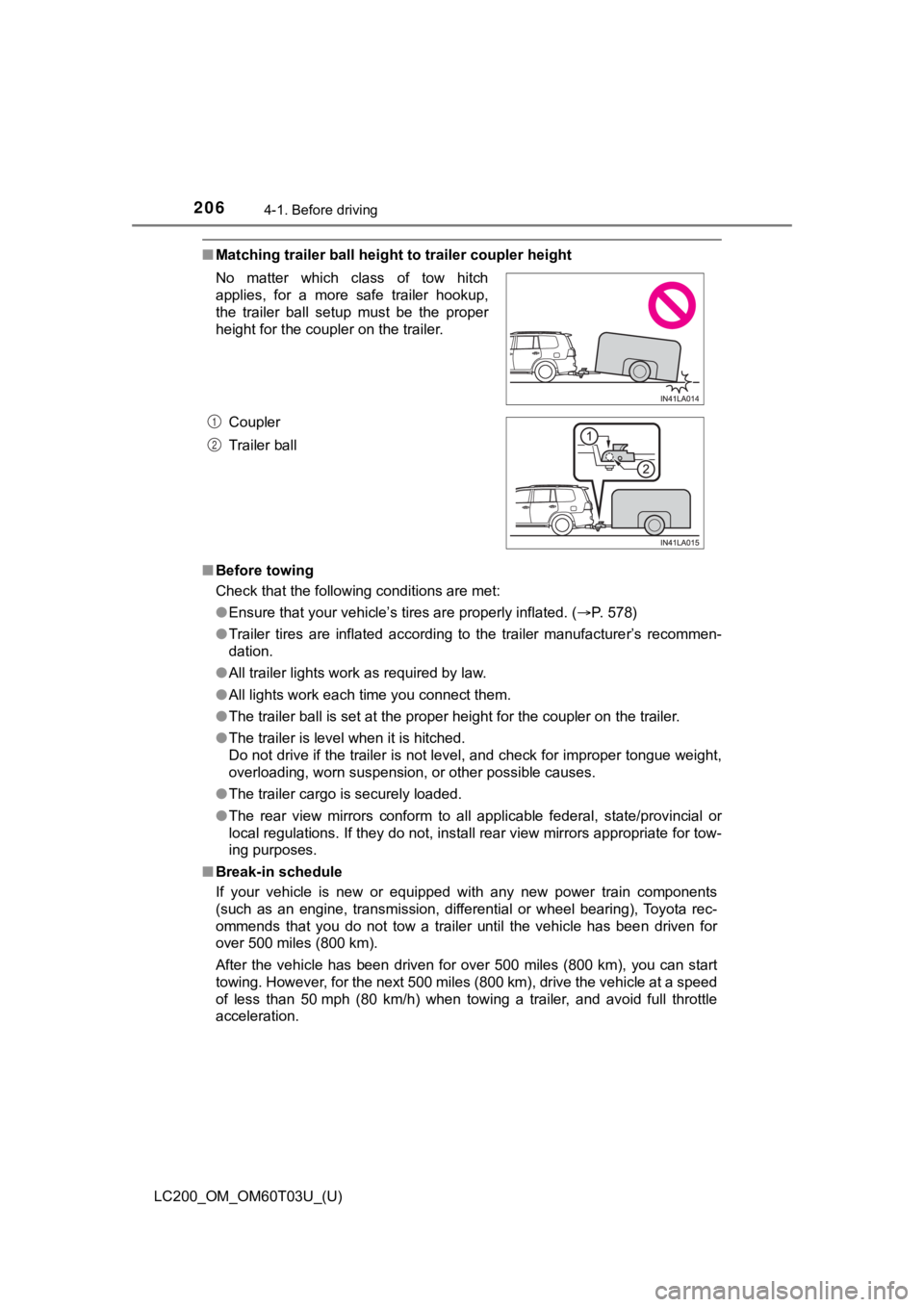
206
LC200_OM_OM60T03U_(U)
4-1. Before driving
■Matching trailer ball height to trailer coupler height
■ Before towing
Check that the following conditions are met:
●Ensure that your vehicle’s tires are properly inflated. ( P. 578)
● Trailer tires are inflated according to the trailer manufacture r’s recommen-
dation.
● All trailer lights work as required by law.
● All lights work each time you connect them.
● The trailer ball is set at the proper height for the coupler on the trailer.
● The trailer is level when it is hitched.
Do not drive if the trailer is not level, and check for imprope r tongue weight,
overloading, worn suspension, or other possible causes.
● The trailer cargo is securely loaded.
● The rear view mirrors conform to all applicable federal, state/provincial or
local regulations. If they do not, install rear view mirrors ap propriate for tow-
ing purposes.
■ Break-in schedule
If your vehicle is new or equipped with any new power train com ponents
(such as an engine, transmission, differential or wheel bearing ), Toyota rec-
ommends that you do not tow a trailer until the vehicle has bee n driven for
over 500 miles (800 km).
After the vehicle has been driven for over 500 miles (800 km), you can start
towing. However, for the next 500 miles (800 km), drive the veh icle at a speed
of less than 50 mph (80 km/h) when towing a trailer, and avoid full throttle
acceleration. No matter which class of tow hitch
applies, for a more safe trailer hookup,
the trailer ball setup must be the proper
height for the coupler on the trailer.
Coupler
Trailer ball
1
2
Page 350 of 632
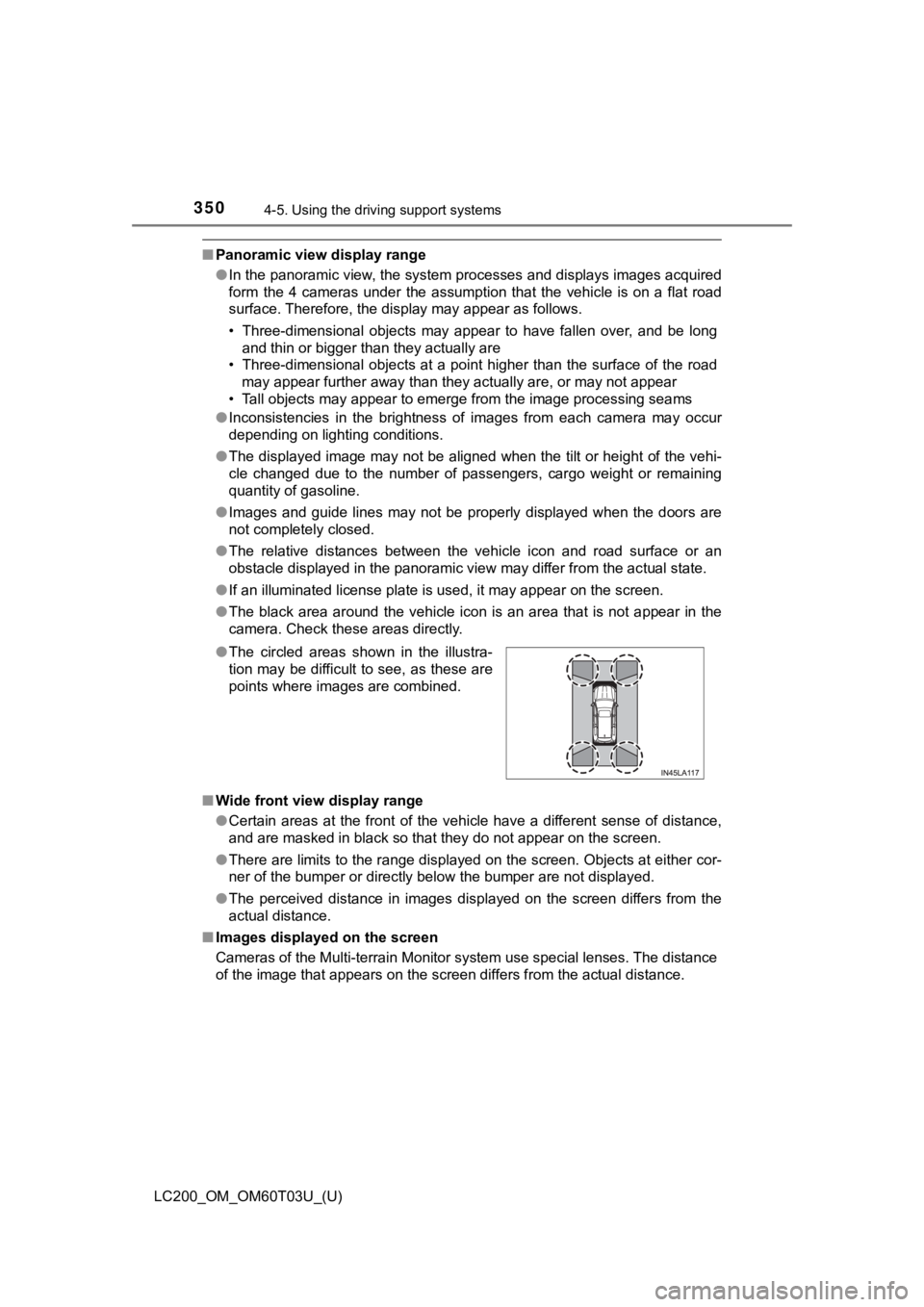
350
LC200_OM_OM60T03U_(U)
4-5. Using the driving support systems
■Panoramic view display range
●In the panoramic view, the system processes and displays images acquired
form the 4 cameras under the assumption that the vehicle is on a flat road
surface. Therefore, the display may appear as follows.
• Three-dimensional objects may appear to have fallen over, and be long and thin or bigger than they actually are
• Three-dimensional objects at a point higher than the surface o f the road
may appear further away than they actually are, or may not appe ar
• Tall objects may appear to emerge from the image processing se ams
● Inconsistencies in the brightness of images from each camera may occur
depending on lighting conditions.
● The displayed image may not be aligned when the tilt or height of the vehi-
cle changed due to the number of passengers, cargo weight or remaining
quantity of gasoline.
● Images and guide lines may not be properly displayed when the d oors are
not completely closed.
● The relative distances between the vehicle icon and road surfac e or an
obstacle displayed in the panoramic view may differ from the ac tual state.
● If an illuminated license plate is used, it may appear on the s creen.
● The black area around the vehicle icon is an area that is not a ppear in the
camera. Check these areas directly.
■ Wide front view display range
●Certain areas at the front of the vehicle have a different sense of distance,
and are masked in black so that they do not appear on the scree n.
● There are limits to the range displayed on the screen. Objects at either cor-
ner of the bumper or directly below the bumper are not displaye d.
● The perceived distance in images displayed on the screen differ s from the
actual distance.
■ Images displayed on the screen
Cameras of the Multi-terrain Monitor system use special lenses. The distance
of the image that appears on the screen differs from the actual distance.
●
The circled areas shown in the illustra-
tion may be difficult to see, as these are
points where images are combined.
Page 370 of 632

370
LC200_OM_OM60T03U_(U)
4-5. Using the driving support systems
■Conditions under which the BSM function may not function correc tly
● The BSM function may not detect vehicles correctly in the follo wing situa-
tions:
• When the sensor is misaligned due to a strong impact to the se nsor or its
surrounding area
• When mud, snow, ice, a sticker, etc. is covering the sensor or surround-
ing area on the rear bumper
• When driving on a road surface that is wet with standing water during bad
weather, such as heavy rain, snow, or fog
• When multiple vehicles are approaching with only a small gap b etween
each vehicle
• When the distance between your vehicle and a following vehicle is short
• When there is a significant difference in speed between your v ehicle and
the vehicle that enters the detection area
• When the difference in speed between your vehicle and another vehicle
is changing
• When a vehicle enters a detection area traveling at about the same
speed as your vehicle
• As your vehicle starts from a stop, a vehicle remains in the d etection area
• When driving up and down consecutive steep inclines, such as hills, dips in the road, etc.
• When driving on roads with sharp bends, consecutive curves, or uneven
surfaces
• When vehicle lanes are wide, or when driving on the edge of a lane, and
the vehicle in an adjacent lane is far away from your vehicle
• When a bicycle carrier or other accessory is installed to the rear of the
vehicle
• When there is a significant difference in height between your vehicle and
the vehicle that enters the detection area
• Immediately after the BSM function is turned on
● Instances of the BSM function unnecessarily detecting a vehicle and/or
object may increase in the following situations:
• When the sensor is misaligned due to a strong impact to the se nsor or its
surrounding area
• When the distance between your vehicle and a guardrail, wall, etc. that
enters the detection area is short
• When driving up and down consecutive steep inclines, such as h ills, dips
in the road, etc.
• When vehicle lanes are narrow, or when driving on the edge of a lane,
and a vehicle traveling in a lane other than the adjacent lanes enters the
detection area
• When driving on roads with sharp bends, consecutive curves, or uneven
surfaces
• When the tires are slipping or spinning
• When the distance between your vehicle and a following vehicle is short
• When a bicycle carrier or other accessory is installed to the rear of the vehicle
Page 384 of 632
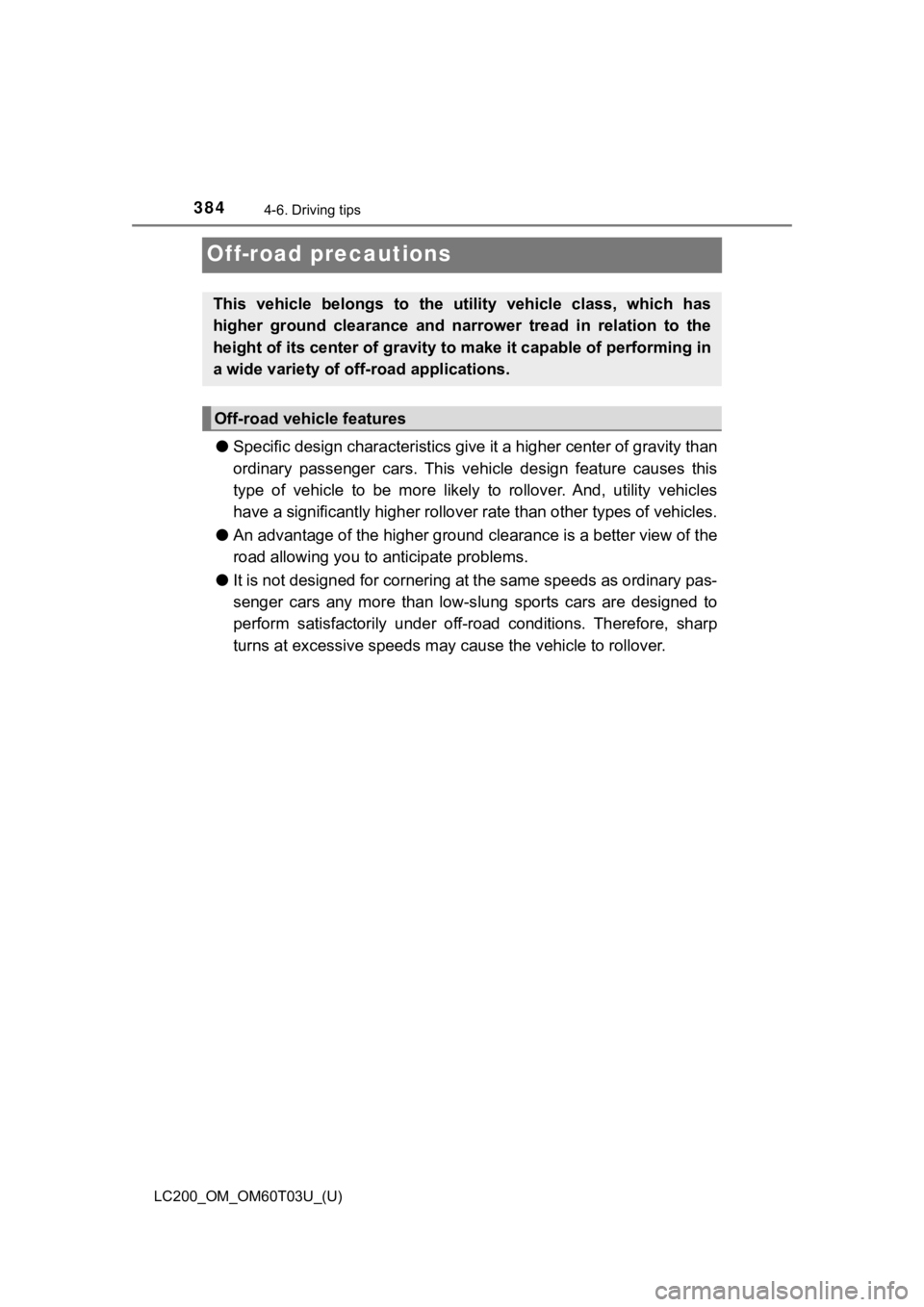
384
LC200_OM_OM60T03U_(U)
4-6. Driving tips
Off-road precautions
●Specific design charac teristics give it a higher center of grav ity than
ordinary passenger cars. This vehi cle design feature causes this
type of vehicle to be more likel y to rollover. And, utility vehicles
have a significantly higher rollover rate than other types of v ehicles.
● An advantage of the higher ground clearance is a better view of the
road allowing you to anticipate problems.
● It is not designed for cornering at the same speeds as ordinary pas-
senger cars any more than low-s lung sports cars are designed to
perform satisfactorily under o ff-road conditions. Therefore, sh arp
turns at excessive speeds may c ause the vehicle to rollover.
This vehicle belongs to the utility vehicle class, which has
higher ground clearance and narrower tread in relation to the
height of its center of gravity to make it capable of performin g in
a wide variety of of f-road applications.
Off-road vehicle features